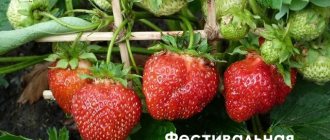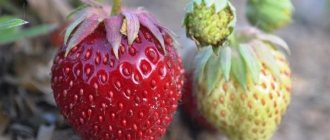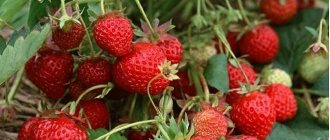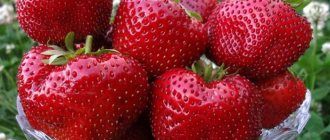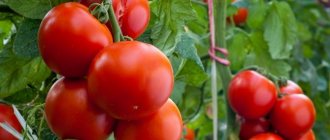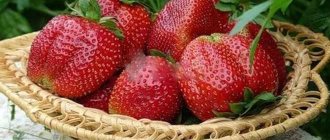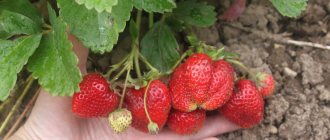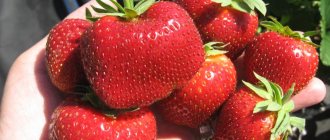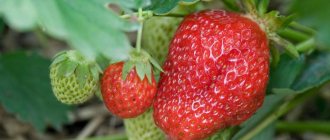Features of beardless strawberries
Strawberries without whiskers are especially loved by gardeners, as they are remontant and bear fruit several times in one growing season.
Caring for such varieties is much easier, because there is no need to periodically trim the shoots to prevent the crop from thickening and growing. In addition, garden strawberries can be planted more closely, which allows you to save space and place more bushes in one bed. The beardless berry can be either large or small in size. Reproduction of varieties is carried out either with the help of seeds from which seedlings are grown, or by dividing the bush. The rest of the agricultural technology is completely the same as that used for varieties with a mustache. It is worth mentioning that day-neutral varieties are often classified as beardless. Their peculiarity is that under comfortable conditions, approximately 5 whiskers are formed on the strawberry, and in hot, dry weather they do not form at all.
Growing bare strawberries
The development of the plant and its fruiting directly depends on the method of propagation and care. In order to grow a healthy young bush, you should know that it is best to do this with seeds. You can grow coquette strawberries by dividing the bush, but this requires special skills and a lot of effort.
Planting of beardless strawberries should be carried out only in fertile and loose substrate.
The soil should consist of humus, sand and peat. You can also use purchased soil to germinate seeds. If you decide to prepare the soil for planting yourself, then it must be heated for 20 minutes. This time will be enough for all kinds of larvae to die and not harm young plants. In order for the seeds to be evenly distributed on the surface of the soil, they must first be mixed with sand.
Seeds should be sown in March or late February. It is recommended to soak the grains in water for 5 hours before use. This will significantly speed up seed growth. At the end of this time, remove the seed from the water and allow it to dry thoroughly.
Strawberries should be sown in small containers. An excellent option would be cups whose height does not exceed 5 cm. Before placing the grains in the soil, the soil should be watered generously. It is not worth deepening the seeds, as they germinate under the influence of sunlight. For quick germination, the containers should be covered with polyethylene and placed on the sunny side. It is best to grow remontant coquette strawberries at a temperature of about 24 0 C. The soil should be moistened with a spray bottle. If everything is done correctly, the first shoots will appear in 2 weeks.
Strawberry Coquette
Strawberry Coquette remontant large-fruited is the most popular variety. It gained its popularity due to its winter hardiness and long-term fruiting. This is a unique plant that has good properties.
A distinctive feature of this species is its abundant fruiting, incredibly sweet taste and aroma of berries. This is a large-fruited garden strawberry, which belongs to the beardless varieties. It grows in the form of small, lush bushes. On each of them, flower stalks are formed several times a season. Medium-sized inflorescences are semi-scattered.
A distinctive feature of this variety is the excellent taste of the berries. They can be consumed both raw and for making jam. The pulp is quite tender and very juicy. The berries are shiny, red in color. The main advantages of this variety: Due to the fact that the plant does not form tendrils, it can be grown in both large and small areas.
The remontant large-fruited strawberry Coquette develops well on various lands. Depending on the climate and planting location, it can bear fruit up to 4 times a year.
Pest Control
As mentioned above, the main scourge of this strawberry is the strawberry mite. This pest damages the leaves, thereby making the plant weaker, which will affect the future harvest of the bush. To combat this type of mite during the growing season, acaricides, “Karate”, Bordeaux mixture 3% are used, and the beds are sprayed with these products.
To summarize, we can determine the main points why Coquette is a favorite among gardeners:
- Due to their compactness and the absence of tendrils, strawberries can be planted not only in large beds, but also in small areas.
- The process of harvesting, weeding and removing weeds is as comfortable as possible.
- Coquette strawberries are dense, so they can be transported over long distances.
- The frost resistance of this strawberry makes this variety very popular in the northern regions, and throughout all regions, due to its resistance to disease.
- Incredible fruitfulness, with proper care up to 4-5 fruitings per year!
By choosing the Coquette strawberry variety, your garden bed will be decorated in the form of fluffy and elegant bushes, and the fruits will delight you with their taste and aromas.
Beardless strawberry Rügen
The variety of German selection, with almost a hundred years of history, is famous for its high productivity. A neat bush with abundant foliage, hung with berries until October, often becomes a decoration of the local area, located in flower beds or along paths. It can grow indoors without requiring additional lighting sources.
The Rügen variety is adapted to the conditions of the Moscow region. The plant demonstrates good disease resistance. Its small bright red oblong berries with dense yellowish pulp inside exude the aroma of wild strawberries and have a sweet, pleasant taste.
Wima Rina's beardless strawberry
For arid areas, those varieties of remontant wild strawberries are suitable that respond well to the absence of watering for some time and continue to bear fruit. “Vima Rina” is just that option. In addition, this is a variety that produces large berries already at the end of June and is resistant to diseases and pests.
Ruyan's beardless strawberry
Among the best varieties of remontant strawberries, this variety is distinguished by its good tolerance of humid conditions when grown on drained soils. This is due to the plant’s resistance to gray rot and high shade tolerance. Considering these features, the crop can be planted under apple trees.
Ruyan's beardless strawberry produces aromatic berries of dense consistency that rise above the foliage and are practically not contaminated by the soil. To obtain a good harvest, moisture deficiency must not be allowed. This will result in less flower buds being formed.
Strawberry Holiday
This beardless, remontant variety of small-fruited strawberries, Holiday, is remarkable for its yellow fruits, which are superior in taste to red-fruited strawberry varieties. The variety forms a compact bush up to 30 cm high; it can also be grown as an ornamental plant in hanging flower pots along garden paths. The berries are very tasty and aromatic, medium-sized egg-shaped. The variety is productive, frost-resistant, and can be grown in all regions of Russia that cultivate this crop.
Bearless strawberry Lyubasha
The beardless variety of remontant large-fruited strawberry Lyubasha is included in the State Register of Russia for all zones of cultivation of the crop. Refers to the early remontant varieties of strawberries. Forms a powerful, well-leaved bush with a semi-spreading shape. It has medium-sized leaves, pubescent, green, shiny, medium wrinkled.
The teeth on the leaves are blunt and wide. The variety is self-fertile. Produces flowers of medium size, white, untwisted. Long and medium peduncles with few-flowered inflorescences are located at the level of the leaves. Large conical berries weighing up to 23 g are located on thick stalks. The tasting rating of fresh berries is 4.9 points.
Description of the strawberry variety Koquette
Characteristics of the strawberry variety Coquette.
An early ripening variety of strawberries (wild strawberries) for universal use. Remontant.
The bush of the strawberry (strawberry) variety Coquette is semi-spreading, well-leafed. There are no mustaches. The leaves are medium-sized, green, slightly wrinkled and slightly ribbed, concave, glabrous, shiny. The leaf teeth are blunt and wide. The shape of the middle lobe of the leaf is oval-rhombic. The petiole of the middle lobe of the leaf is longer than the lateral ones. The leaf petiole is thick. Stipules are green with anthocyanin color. The flowers are bisexual, medium-sized, white, untwisted. Peduncles are long, medium-sized, located below the leaves. The inflorescence is semi-spreading, few-flowered. The stalks are long and thick.
Berries of the strawberry variety (strawberries) Coquette of regular conical shape, weighing from 17 to 23 g, orange-red, shiny, with a neck. They contain: sugar 9%, vitamin C 65 mg/%. The taste of the berries is sweet and sour with aroma. The pulp is tender, juicy, the tasting rating of fresh berries is 4.6 points.
Average yield up to 163 c/ha. Winter hardiness is high, drought resistance is average. Resistance to diseases is at the level of standard varieties, resistance to strawberry mites is weak.
The strawberry variety Koketka is included in the State Register of the Russian Federation for crop cultivation zones.
description-sorta.ru
How to grow varieties of strawberries from seeds
Landing time. Strawberry seeds are usually planted in the second half of February (the period is indicated for the middle zone).
To grow strawberry seedlings, low (5–6 cm) but wide containers are used. It is convenient to use a ready-made plastic container with a lid. To remove excess water and improve air circulation, punctures are made in the bottom and lid.
Neat holes in a plastic container are obtained by using a hot awl or needle.
The container is filled with soil. You can use a homemade soil mixture of sand, vermiculite and leaf humus (1:1:1). Ready-made soil for seedlings is also suitable (as we wrote earlier, GreenWorld brand seedling soil is ideal for these purposes). Before filling the container, the soil is sifted. Strawberries prefer loose neutral soil, without excess nutrients.
Strawberry coquette: reviews
On gardening forums you can often read the most positive reviews about the Koketka remontant strawberry. It is valued for its excellent germination, rich harvest and excellent taste of the berries. Particularly difficult for novice gardeners is the long-term cultivation of strawberry seedlings from seeds, since in the process of picking the seedlings, the fragile and thin stems of the seedlings quickly break. Seedlings should be planted with extreme caution. The best option is to use peat tablets for growing seedlings, which avoid diving. Otherwise, the remontant strawberry Koketka is an ideal variety for the garden.
A bountiful harvest of fragrant, juicy large berries can be harvested several times during the summer season, enjoying their extraordinary strawberry flavor.
Technology for caring for bare strawberries
A remontant plant that bears fruit throughout the growing season requires special care. It must be supplied with nitrogen/potassium on a regular basis. This goal is accomplished by using:
- Chatterboxes (compost);
- Manure slurries;
- Herbal fertilizers;
- Gumatov.
The main condition for natural development will be constant watering in moderate doses. After watering, the soil base is loosened, due to which the root-type system begins to actively operate.
Reddened leaves should be removed on a regular basis. After the initial harvest, each leaf should be carefully trimmed without harming the growing point of the plant. Only the leaf blades need to be cut off.
They respond well to the addition of organic matter - a solution of cow manure or bird droppings. Watering with an infusion of fresh herbs also has a beneficial effect on development. Fertilizing with organic matter should be alternated with the application of complex mineral fertilizers intended for berry crops. It’s a good idea to sometimes add wood ash to the soil.
Growing wild strawberries undoubtedly has many advantages. These are excellent yields, immunity of berries to various diseases, simple methods of propagation, simple care, good adaptability to a variety of weather conditions.
True, the variety also has a significant drawback - poor tolerance to low temperatures.
Features of beardless strawberries
One of the agricultural techniques when caring for strawberries is removing the whiskers. Shoots growing in different directions draw on nutrition, which reduces the number of flowers and affects the yield of the crop. Thanks to breeders, garden strawberries have been developed that form a small number of creeping shoots. In some varieties the mustache is completely absent.
In addition to the absence of whiskers, many species are capable of bearing fruit repeatedly during the season (remontability). Kidney formation occurs according to different patterns:
- with long daylight hours (LDD);
- at neutral daylight hours (NDD).
On a note! Varieties of ordinary garden strawberries that bear fruit once a season (spring - early summer) belong to the short daylight (SD) species.
DSD varieties produce crops 2 times a season, while representatives of NSD produce harvests throughout the entire growing season. Small-fruited garden strawberries and large-fruited bush strawberries with high frost resistance have been bred.
The “advantages” of such types include:
- high yield of varieties;
- disease resistance;
- extended fruiting period;
- easy care;
- suitability of berries for transportation, which is attractive for farmers and summer residents who grow strawberries for sale.
Since the bushes do not produce mustaches (or there are very few of them), it is necessary to propagate the varieties by seeds or divide the bush of mature, without mustache strawberries. The first option is labor-intensive, but ensures a clean look. Under normal conditions in the country, garden strawberries without tendrils are most often propagated by division.
Due to prolonged abundant fruiting, plants quickly lose productivity; large-fruited varieties begin to become smaller after 1-2 years, reducing harvest rates. Small-fruited varieties do not form a full-fledged berry and degenerate. Therefore, it is necessary to regularly update strawberry plantations, plant fresh bushes in new, well-fertilized beds, and then carefully care for the plantings.
Old bushes are planted (divided), the variety is propagated through sowing seeds and growing seedlings. Young plants are transplanted to a permanent place, taking into account their predecessors and the characteristics of the variety. By ensuring regular watering and fertilizing throughout the growing season, even novice gardeners will reap an excellent harvest of sweet berries.
Strawberry Coquette - characteristics, planting rules and care methods
This article will introduce you closer to the description of the remontant strawberry variety Koketka. Among all varieties of remontant strawberries, Koketka is the most popular due to its frost resistance and long-term fruiting.
Features and characteristics
The first feature of the Koketki variety is that it belongs to the beardless strawberry varieties. Its appearance is small but voluminous bushes. A large number of oval leaves give the bushes a lush appearance. In one season, several flower stalks can form on each individual bush. The cone-shaped berries of the Coquette strawberry are very juicy, sweet and have an exquisite aroma.
This strawberry variety Koketka gained its popularity among gardeners not only due to its taste, but also due to its abundant fertility. In addition, the Koketka variety is an early-ripening strawberry.
The approximate weight of one strawberry can be from 17 to 25 grams.
You can also add to the pluses the beneficial properties of the Coquette strawberry, which contains 65% vitamin C. The berries are suitable both for consumption raw and for making preserves, liqueurs and jams.
Due to the fact that Coquette bushes take up little space, they can be grown in small beds. They are easy to treat against weeds and easy to harvest. Despite the fact that the strawberry variety Koketka is resistant to diseases, its weak point is the strawberry mite.
This remontant strawberry is not picky about soil, so it can grow in almost any soil. The coquette will grow on one piece of land for many years, but due to the fact that it grows quickly, the yield may decrease.
In order to avoid this, gardeners advise planting bushes every 4 years.
Tips for growing barless strawberries Coquette
Growing the strawberry variety Coquette by division is a very difficult task, so it will be easier and better to try to germinate the seeds. The seed planting method will have a positive effect on the fertility and development of the bush.
Since the seeds grow slowly, it is best to start planting in February-March. Before placing the seedlings in the ground, the seeds require preparation:
- You should soak the seeds first, this will speed up their growth. You need to take the Ecorin solution, dilute 5 drops of this solution in 50 ml of water, and place the seeds on gauze soaked in this material. This will keep the seeds well hydrated before planting. Leave for 5 hours.
- The next step is to take out the seeds and let them dry.
- Moisten the soil in the ground, only then can the seedlings be planted.
- Tweezers should be used to place the seeds into the ground.
- There is no need to bury deep or cover the seeds with soil; you need to apply gentle pressure so that the seed goes smoothly into the soil.
- Since the main assistant in the growth of strawberries is the sun, you should plant 1 seed per container, or keep a distance of one and a half, two centimeters.
- After planting the seeds, sprinkle the soil again with water and cover it with an object that would transmit light and create favorable conditions for the development of the seedling.
- The container with seeds must be kept in a warm place with a temperature of at least 24 degrees, the room must also be well lit.
- Every day, do not forget to maintain moisture in the pots and ventilate the container with the seeds.
- In just 10-14 days you will be pleased with the first sprouts of the Coquette strawberry.
Planting in open ground
As soon as the sprouts in the seedlings show the first 2-4 leaves, the plant must be pruned. This is the case if the strawberries were planted in a common container. Already strong Coquette bushes can be transplanted into open ground. This should be done 6 or 7 weeks after planting the seeds, approximately in the month of May.
In order for the seedlings to get used to temperature changes, before planting, you can take them outside for several hours and leave them in the shade.
Before planting, the beds must be cleared of weeds and twigs and the soil must be fertilized. Compost or humus is suitable as a fertilizer. Immediately after planting strawberries of the Koketka variety in the soil, they need to be watered abundantly. Further care for Coquette is the same as for other varieties, watering, weed control and mandatory loosening of the soil.
Pest Control
As mentioned above, the main scourge of this strawberry is the strawberry mite. This pest damages the leaves, thereby making the plant weaker, which will affect the future harvest of the bush. To combat this type of mite during the growing season, acaricides, “Karate”, Bordeaux mixture 3% are used, and the beds are sprayed with these products.
To summarize, we can determine the main points why Coquette is a favorite among gardeners:
- Due to their compactness and the absence of tendrils, strawberries can be planted not only in large beds, but also in small areas.
- The process of harvesting, weeding and removing weeds is as comfortable as possible.
- Coquette strawberries are dense, so they can be transported over long distances.
- The frost resistance of this strawberry makes this variety very popular in the northern regions, and throughout all regions, due to its resistance to disease.
- Incredible fruitfulness, with proper care up to 4-5 fruitings per year!
By choosing the Coquette strawberry variety, your garden bed will be decorated in the form of fluffy and elegant bushes, and the fruits will delight you with their taste and aromas.
Strawberry Coquette - characteristics, planting rules and care methods Link to main publication
Source: https://VashaKlubnika.ru/sort/klubnika-koketka
Small-fruited beardless strawberries: choice for different regions
Varieties of garden strawberries with medium-sized berries have excellent taste. At the height of fruiting, fragrant berries shower the bushes, filling the air around with an incredible strawberry aroma.
"Alexandria"
Developed in the USA, it is known for its long-lasting fruit production.
On a note! Strawberries "Alexandria" are suitable for planting on ridges of open ground, as well as in pots, flowerpots for growing on a windowsill, on balconies and loggias.
Bushes with spreading flower stalks, tall and thin. The berries are conical, rich red in color with gloss, weigh 6-8 grams (for small-fruited varieties this is a lot of weight). The achenes are red, slightly depressed. There is a characteristic strawberry aroma. The approximate fruiting time is from early June to mid-October. 350-400 grams of berries are harvested from the plant per season.
"yellow miracle"
The yellow-golden berries of this strawberry look original against the background of green foliage. The variety is German, propagated by seeds or by dividing the bush, since there are no mustaches on the plant.
The berries are elongated, elliptical in shape, with golden achenes on the surface. They weigh no more than three grams. The taste is sweet, with a characteristic pineapple aftertaste and aroma. Since the fruits do not contain red pigment, they can be eaten even by allergy sufferers.
"Baron Solemacher"
A time-tested variety from Germany, it is famous for its excellent taste of berries with a bright strawberry aroma. Plants are small, well leafy. The leaves have serrated edges, light green with a silvery tint. Fruiting begins in the first year after planting, the highest yield is in 2-3 years. Transplantation – after 4 years.
The fruits are small, up to 3-4 grams in weight, bright red. They ripen in the middle zone in early June, bearing fruit until early September. In the southern regions, the last collections are in November.
"rügen"
Winter-hardy garden strawberries were bred many years ago in Germany. The bushes grow up to 18-20 cm, the peduncles are strong and erect. During the ripening period, the berries do not lie on the surface of the ground, they are always clean, and do not rot.
The fruits are small, up to 2.5-3 grams, scarlet-red in color. The tip of unripe berries is slightly whitish. The achenes are large and located on the surface. The taste is excellent, the flesh is dense and sugary.
Planting requires rejuvenation every three years. The variety is demanding on watering and soil fertility. With proper agricultural technology, it bears fruit until frost.
"Ali Baba"
These delicious garden strawberries are famous for their abundant harvests (up to 0.5-0.7 kg). The bushes are powerful and leafy. They bloom and bear fruit in the first season. During the flowering period, the plants are strewn with numerous white “caps” of inflorescences.
The berries are slightly elongated and resemble wild strawberries in shape. Weight – 6-8 grams, achenes are small. The skin color is bright red, the core is milky white with pink splashes. The bushes tolerate cold weather well and quickly adapt to different climatic conditions.
"Forest Tale"
According to reviews from those who grew this variety, it is very similar in taste and aroma to the berries of real wild strawberries. The name is one hundred percent justified. A medium-sized plant with tall peduncles and bright green foliage.
Strawberry Coquette, planting and care
Remontant strawberries are popular among summer residents and gardeners for their ability to bear fruit repeatedly throughout the growing season. There are more than 200 varieties of remontant strawberries, which in terms of taste are not inferior to the well-known non-remontant varieties of garden berries. One of the most attractive early-ripening varieties of aromatic berries for summer residents is the remontant strawberry Koketka. The variety is famous for its winter hardiness, long-term fruiting up to 3-4 times per season, depending on the growing region, and large, red berries with an unforgettable sweet taste and aroma. Read on to learn how to grow the strawberry variety Koquette from seeds at your summer cottage.
Strawberry Coquette: description
“Coquette” is a large-fruited garden strawberry that belongs to the remontant, beardless varieties. This is a frost-resistant, early-ripening variety. Coquette bushes are lush, spreading, with elongated peduncles. Inflorescences are small, semi-spreading. The abundance of oval-shaped foliage with small serrations creates the impression of fluffiness of the bush and makes the strawberry attractive and flirtatious. The early ripening variety Koketka is considered one of the most productive. The berries are large, cone-shaped, have a sweet and sour taste and a bright aroma. The weight of an average strawberry is from 17 to 25 grams. Juicy berries have excellent taste, contain up to 9% sugar and 65% vitamin C, and are suitable for delicacy both fresh and for making preserves, jams, liqueurs and desserts. Despite its resistance to various diseases, the Koketka variety has a significant drawback - it has weak resistance to the strawberry mite.
Strawberry coquette: photo
- By following all agrotechnical measures for growing a remontant variety, it is possible to harvest a rich harvest of strawberries 2-3 times per season.
- Since Koketka is a beardless variety, it can be grown in even a small area, which is especially important for small gardens and summer cottages.
- Neat bushes that do not have tendrils are easy to weed and are more convenient to harvest from.
- The variety has high yield, and the berries are transportable. It is these qualities of the Koketka strawberry that attract farmers who grow strawberries.
- Coquette is resistant to diseases and tolerates frosty winters well; it can be grown in the coolest regions.
Strawberry coquette: growing from seeds
To grow strawberries in the country, it is easier to buy ready-made seedlings, but many gardeners prefer to grow a bountiful harvest themselves, from seeds. Moreover, this activity is not difficult. It is enough to follow the basic recommendations for growing remontant strawberries. They begin to sow seeds for seedlings in February, in the southern regions - in March, since the seedlings grow for quite a long time.
Preparing the soil for planting strawberries Coquette
The soil for growing strawberry seedlings must be loose and fertile, consisting of humus, sand and peat. You can use ready-made soil for seedlings. If you prepare the soil mixture yourself, it must be calcined, that is, placed in the oven for 15-20 minutes to destroy the larvae of possible pests that can harm young seedlings. Strawberry seedlings need good moisture, so before sowing the seeds, the soil in the container is generously moistened. Containers for growing seedlings should be shallow, no more than 5 cm in height; small cups or pots are perfect.
Planting strawberry seeds Coquette
Coquette strawberry seeds are small, germinate very slowly and require mandatory preparation before sowing in the ground:
- Seed material needs to be soaked to speed up the growth of seedlings. To do this, they are placed on gauze or a cotton pad soaked in Ecorin solution (5 drops per 50 ml of water) and left for 5 hours to moisturize.
- After this, the strawberry seeds are laid out on a clean sheet of paper and allowed to dry slightly. Wet seeds are more difficult to plant in the soil.
The next stage is planting the seeds in pots with soil. Before planting, moisten the soil with a spray bottle. Since the seeds are quite small, tweezers or a toothpick are used for planting.
- When burying a seed, you should only press it slightly onto the ground. There is no need to sprinkle it with soil - strawberry seeds germinate under the influence of sunlight. One seed is placed in one pot; if planting is carried out in a large container, the distance between plantings should be within 1.5-2 cm.
- Having planted the seeds in the ground, it is necessary to moisten them again and cover them with film or transparent glass, creating the moist microclimate necessary for the growth of seedlings.
- Containers with planting are placed in a warm, well-lit place. Seedlings should be kept indoors at a temperature of 20-24 degrees.
- The soil should be ventilated and moistened daily using a spray bottle.
- The first small sprouts of strawberries appear after 1-2 weeks.
If the seeds were planted in a common box, then the seedlings must be picked. You can start picking strawberry seedlings when 2-4 leaves appear on the sprouts, that is, about a month after sowing the seeds. It is worth remembering that strawberry seedlings are very fragile and tender. The seedling is transferred using a spoon, file or other improvised object into prepared cups with soil. When planting seedlings, special attention should be paid to the growth point of the sprout, which cannot be placed deep in the soil. Picked seedlings are watered using a pipette or rubber bulb and placed in a place away from direct sunlight to give them time to adapt to new conditions.
Planting strawberry seeds Coquette in peat tablets
Very often, gardeners use peat tablets to grow strawberry seedlings, which greatly simplify the planting process, because picking the seedlings is not required. Each strawberry seed is planted in a moistened, water-swollen peat tablet in the same way as described above. It is advisable to place peat tablets with seeds planted in them on a pallet. After the young strawberry bushes have grown stronger, they can be planted in the beds.
Planting strawberries Coquette in open ground
Strong seedlings can be planted in open ground 6-7 weeks after planting - in the second half of May. In order to harden young strawberry seedlings and prepare them for new growing conditions, boxes with seedlings are taken outside for several hours every day, placing them in the shade of trees.
The bushes are planted in prepared beds, cleared of weeds. The soil for growing strawberries must be fertilized with compost or humus, which is added during digging in the fall. After planting, the strawberry bushes are watered abundantly. Subsequent care for strawberries consists of watering the plant, loosening the beds to enrich the soil with oxygen, and destroying weeds.
Strawberry pests Coquette
The most dangerous enemy of strawberries of the Koketka variety is the strawberry mite. This is a rather small insect that can cause irreparable damage to the future strawberry harvest. The strawberry mite infects the leaves of the plant, deforming and weakening the plant.
To combat the pest, insecticides and acaricides are used during the growing season: “Arrivo”, “Karate”, 3% Bordeaux mixture, which is sprayed on the plantings.
Strawberry coquette: reviews
On gardening forums you can often read the most positive reviews about the Koketka remontant strawberry. It is valued for its excellent germination, rich harvest and excellent taste of the berries. Particularly difficult for novice gardeners is the long-term cultivation of strawberry seedlings from seeds, since in the process of picking the seedlings, the fragile and thin stems of the seedlings quickly break. Seedlings should be planted with extreme caution. The best option is to use peat tablets for growing seedlings, which avoid diving. Otherwise, the remontant strawberry Koketka is an ideal variety for the garden.
A bountiful harvest of fragrant, juicy large berries can be harvested several times during the summer season, enjoying their extraordinary strawberry flavor.
dachnaya-zhizn.ru
Description and varietal characteristics
The strawberry variety “Lyubasha” is characterized by the formation of powerful semi-spreading bushes. There is no formation of whiskers on berry plantings of this variety. The stalks are thick and strong. The berries have a regular conical shape. The average weight of a fully ripened berry is 18-22 g. A distinctive feature of ripe pulp is the increased content of vitamin C and sugars.
According to most consumers, the taste of ripe strawberries is excellent. The pulp is very sweet, with a pronounced strawberry aroma. According to the tasting results, the variety received a score of 4.9 points. The collected berries are perfect for freezing for the winter.
Large-fruited garden strawberries "Lyubasha" belong to the winter-hardy category. Unlike varieties of classic garden strawberries, their flowering is continuous and fruiting is very long. In the soil and climatic conditions of central Russia, the fruit formation period is three months. When this remontant variety is cultivated in the southern regions, fruiting lasts about five months.
Strawberry coquette: growing from seeds
To grow strawberries in the country, it is easier to buy ready-made seedlings, but many gardeners prefer to grow a bountiful harvest themselves, from seeds. Moreover, this activity is not difficult. It is enough to follow the basic recommendations for growing remontant strawberries. They begin to sow seeds for seedlings in February, in the southern regions - in March, since the seedlings grow for quite a long time.
Preparing the soil for planting strawberries Coquette
The soil for growing strawberry seedlings must be loose and fertile, consisting of humus, sand and peat. You can use ready-made soil for seedlings. If you prepare the soil mixture yourself, it must be calcined, that is, placed in the oven for 15-20 minutes to destroy the larvae of possible pests that can harm young seedlings. Strawberry seedlings need good moisture, so before sowing the seeds, the soil in the container is generously moistened. Containers for growing seedlings should be shallow, no more than 5 cm in height; small cups or pots are perfect.
Planting strawberry seeds Coquette
Coquette strawberry seeds are small, germinate very slowly and require mandatory preparation before sowing in the ground:
- Seed material needs to be soaked to speed up the growth of seedlings. To do this, they are placed on gauze or a cotton pad soaked in Ecorin solution (5 drops per 50 ml of water) and left for 5 hours to moisturize.
- After this, the strawberry seeds are laid out on a clean sheet of paper and allowed to dry slightly. Wet seeds are more difficult to plant in the soil.
The next stage is planting the seeds in pots with soil. Before planting, moisten the soil with a spray bottle. Since the seeds are quite small, tweezers or a toothpick are used for planting.
- When burying a seed, you should only press it slightly onto the ground. There is no need to sprinkle it with soil - strawberry seeds germinate under the influence of sunlight. One seed is placed in one pot; if planting is carried out in a large container, the distance between plantings should be within 1.5-2 cm.
- Having planted the seeds in the ground, it is necessary to moisten them again and cover them with film or transparent glass, creating the moist microclimate necessary for the growth of seedlings.
- Containers with planting are placed in a warm, well-lit place. Seedlings should be kept indoors at a temperature of 20-24 degrees.
- The soil should be ventilated and moistened daily using a spray bottle.
- The first small sprouts of strawberries appear after 1-2 weeks.
Strawberry pick Coquette
If the seeds were planted in a common box, then the seedlings must be picked. You can start picking strawberry seedlings when 2-4 leaves appear on the sprouts, that is, about a month after sowing the seeds. It is worth remembering that strawberry seedlings are very fragile and tender. The seedling is transferred using a spoon, file or other improvised object into prepared cups with soil. When planting seedlings, special attention should be paid to the growth point of the sprout, which cannot be placed deep in the soil. Picked seedlings are watered using a pipette or rubber bulb and placed in a place away from direct sunlight to give them time to adapt to new conditions.
Advantages and disadvantages
Remontant varieties of garden strawberries have great advantages compared to the classic varieties of this berry crop:
- high level of productivity of berry plantings;
- sufficient indicators of frost resistance and winter hardiness;
- the opportunity to obtain a large, marketable berry;
- after the first fruiting, the plant again sets buds and sets berries, which allows you to get several full harvests per season;
- resistance to the main most common diseases at the level of standard varieties;
- sufficient indicators of drought resistance and heat resistance;
- excellent taste of fully ripened berries;
- possibility of universal use of the harvested crop.
The disadvantages of remontant varieties, including “Lyubasha,” include the need to grow using seedlings. It is recommended to sow seeds from February to July. Planting seedlings on ridges in open ground is done when five or six true leaves appear on the bush.
The formation of flower buds on remontant varieties of garden strawberries for the second harvest begins during the first flowering. After harvesting the ripened berries, repeated, quite abundant flowering occurs. Due to this feature, caring for remontant strawberries is slightly different from working with conventional varieties of this berry crop.
Features of care and harvesting
The main condition for obtaining a good strawberry harvest is the creation of the most favorable growing conditions that can ensure normal growth and development of the berry crop:
- the area for strawberries must be dug up and completely cleared of plant debris and weeds;
- watering is carried out as the soil dries, in the early morning and late evening, with warm water;
- It is not recommended to use fresh manure for fertilizing;
- the best fertilizers are humus, bird droppings, as well as mineral, phosphorus and potassium compounds;
- when planting seedlings for the first time, 10 kg of organic matter and approximately 30-34 g of minerals should be added to the soil;
- In early spring and autumn, it is necessary to remove old and dry leaves from the plant.
It is very important to carry out timely preventive measures and spraying aimed at protecting berry plantations from diseases and pests. In the spring, after removing old leaves from the plant, but before the flowering stage, the berry bushes are sprayed with iodine solution, Bordeaux mixture or copper oxychloride.
Ripe berries are collected in several stages, at the stage of full ripening. Strawberries on the bushes should not be allowed to overripe: this can provoke rot and reduce the overall yield, as well as deteriorate the quality of the berries.
Tips and reviews from gardeners
The strawberry variety "Lyubasha" is unpretentious. According to reviews from experienced summer residents, plants are very responsive to periodic loosening of the soil, which allows air access to the root system of the berry crop. It is also important, if necessary, to add fertile soil to protect the root system from exposure. It is recommended to carry out periodic inspections of strawberry bushes, as well as regularly remove weeds from the ridges. Ripening berries should not be placed on the soil. It is necessary to lift them using ring-shaped wire supports.
Growing garden strawberries "Lyubasha" is not difficult, so this variety is perfect for cultivation by novice gardeners.
Sources:
https://fermerx.ru/uborka-i-uhod/zemlyanika-koketka-remontantnaya-krupnoplodnaya-opisanie-sorta-video/ https://sovusadba.ru/sad/yagody/luchshie-sorta-bezusoy-sadovoy-zemlyaniki- opisanie-s-foto-rekomendatsii-po-vyboru.html https://dachadecor.ru/yagodi/remontantnaya-krupnoplodnaya-zemlyanika-liubasha



